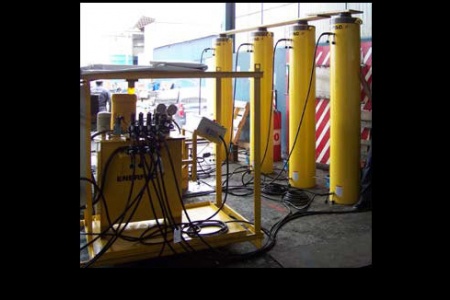Undecking an Electric Rope Shovel
Customer:P&H MinePro
Location:Chile
P&H MinePro® Chile services some of the biggest equipment around. The company knows from experience the complexity, difficulty, and safety concerns that arise when doing a multipoint lift of heavy equipment. When MinePro needed a new hydraulic lifting system capable of high capacity and high accuracy that could be safely and easily controlled by operators, it turned to Enerpac Integrated Solutions for a digitally controlled lifting system.
The hydraulic system configured for MinePro consists of four, 500-ton double-acting cylinders with a 72-inch stroke, laser position sensors, hydraulic power unit, electrical controllers and operator interface. MinePro has integrated this system into both bracket-type and large frame-type lifting apparatus designed to lift shovels in the P&H 2800 and 4100 families.
Shovel lift system
MinePro had to design the lifting structures to be particularly rugged, because copper mines in Chile are located at very high altitudes with frequent high winds and occasional earthquakes. An anti-vibration system is incorporated to absorb movements generated by earthquakes. With the digitally-controlled jacking system, the operation was completed in substantially less time than anticipated.
The lift apparatus makes full use of laser position sensors and 72-inch stroke jacks. The equipment was provided through Enerpac distributor Hidromec®, established in 1981 by Leonel Gimenez, a former mining technician with more than 29 years of experience in mining hydraulics.
Synchronized lifting system
Hydraulic jacking is the obvious method for lifting the mammoth P&H shovels, but controlling the lifting process manually would have meant using a number of reliable people to individually control the jacks. It would also have meant a lot of radio chatter among the jack operators, since none of the lift points is visible from the other points. There would be a lot of possibilities for confusion and error, raising concerns about safety and the possibility of damage to the shovel. Bringing control of all four jacks to a single operator station reduces the number of people in the loop, but then the operator of such a system would not be able to see all the jacking points, and the possibility of operator error remains.
The solution lay in a combination of traditional hydraulics with a digital controller, sensors, and actuators—“synchronized lifting.” In the Enerpac Integrated Solutions sync-lift system, a PLC controller monitored load position at each lift point to within one millimeter (0.040 in.) by means of a cylinder displacement sensor associated with each jack.
The position sensors are often electro-mechanical devices, with mechanical construction analogous to that of a tape measure, unwinding a fine wire from a spool to a fixed reference point. The high winds common at MinePro’s Chilean high-altitude (around 11,000 ft) worksites precluded use of such devices for accurate position sensing. Instead, a laser stroke-position sensor was used for each jack. The resulting signals are fed to the digital controller, which operates solenoid valves for each jack as needed.
Additionally, the controller accurately senses the load at each jack, in essence providing a load cell at each lift point. The controller’s touch screen gives the operator position and load readouts by point and total. Training and on-site assistance were factors in the equipment selection, but the digitally controlled hydraulics also affords the following significant advantages to MinePro:
- Increased safety—The digital controller eliminates the possibilities for confusion and error inherent in a multioperator manual control approach. Unlike a manual approach where a person has to be stationed at each cylinder to take and report measurements and operate valving, nobody has to be close to the lifted equipment. This is particularly significant if an unexpected event occurs, such as a load shift. The controller also has warning and stop capabilities.
- Increased productivity—Considerably less staffing is required than for a manually controlled lift. One person controls the entire lift. The actual raising process can also proceed more rapidly because the status of every lift point is constantly displayed. A job that formerly took 24 hours or more can be completed in about eight hours.
- Less chance of property damage—With all lift points constantly monitored and automatically controlled, concerns about overstressing some part of the shovel structure due to uneven lifting are eliminated. This is particularly important for uneven loads.
- Adaptability—The mechanical components and digital controller can be configured to suit varying work needs.
The P&H MinePro-Chile Shovel Lifter incorporating synchronized lifting has delivered levels of safety and productivity that are now attracting the attention of other MinePro divisions, and distributor Hidromec has acquired a synchronized lifting system for service and rental use.
Bernd Schmidt is a Territory Manager for Enerpac, a manufacturer of hydraulic equipment and systems (www.Enerpac.com).





